Navigating the world of the healthiest cookware and safest cookware has been an integral part of my health journey. With two cooking websites under my belt, I’ve encountered countless brands, materials, and styles.
Over the years, I’ve tried my hands on multiple brands. One thing became clear: not all “healthy” cookware is created equal. Some may flaunt their non-toxic labels, but they might disappoint when it comes to performance – sticking, warping, or simply not lasting. Others might be stellar performers but fall short in the aesthetics and convenience department or have added toxic components.
Related: Top Best Non-Toxic Bakeware, Baking Sheets and Pans (Safe Materials)

This deep dive into the culinary realm and my health journey, which began 10 years ago, (initially focused on choosing safe beauty products) has equipped me with insights regarding the safest cookware options, that I’m eager to share.
Below, I’ll detail the safe and healthy materials found in today’s cookware, discuss their pros and cons (especially when it comes to food combining) and provide examples of top non-toxic cookware brands currently on the market (end of 2023) to help you make an informed choice based on your needs.
Related: Meal Prepping Vegetables: How to Keep Veggies Fresh Longer
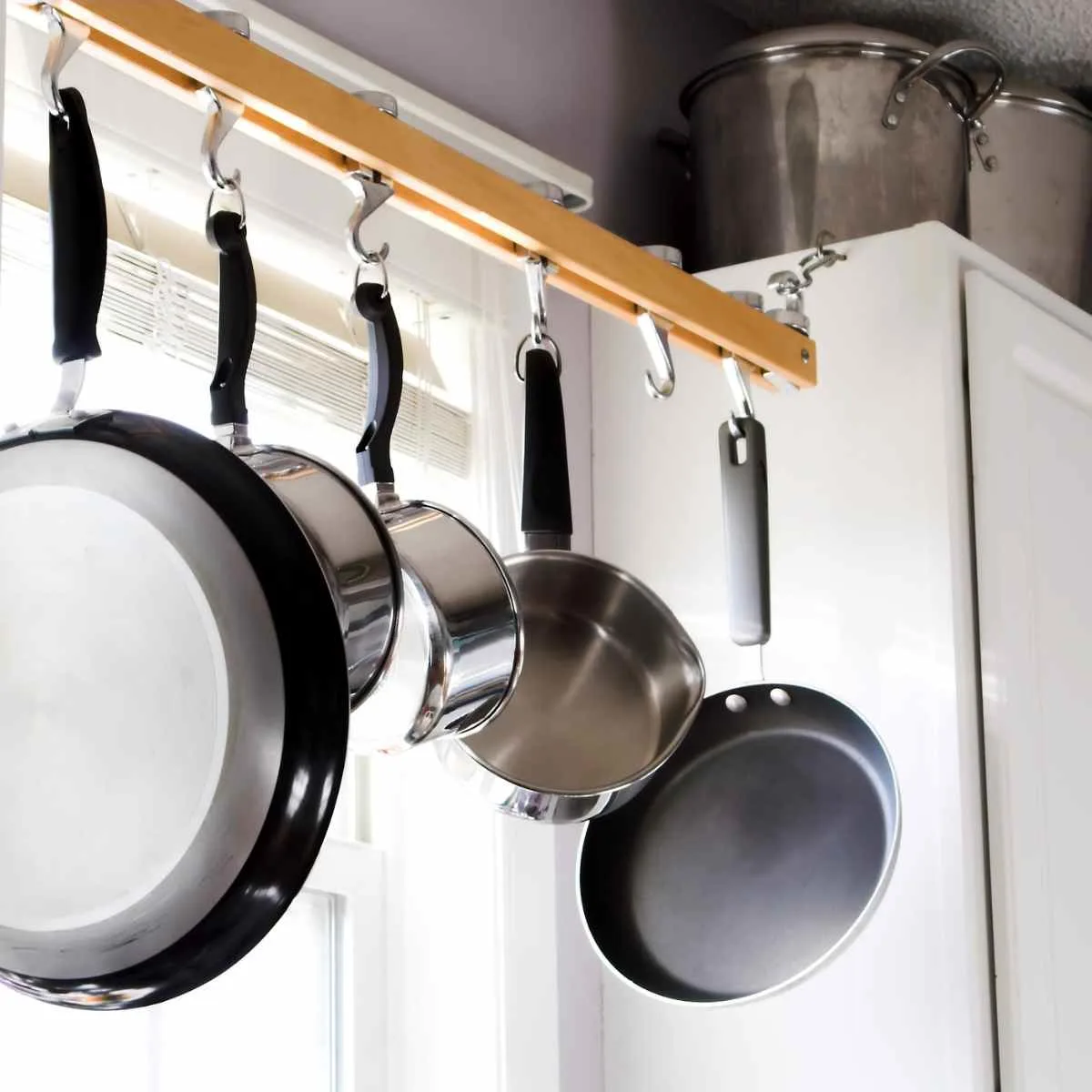
Primary Factors Determining The Health and Safety of Cookware Include:
- Material Composition: Safe and healthy cookware should be free of lead, cadmium, chromium, aluminum and other heavy metals. Also PFOA (previously used to manufacture teflon), PFAS group, PTFE, free from glues and other toxic coatings and dyes. All these can leach into food when cooking and also highly toxic when inhaled, posing a serious health hazard.
- Avoidance of Reactive Metals: Metals prone to leaching, such as aluminum and copper, shouldn’t come into direct contact with food. For instance, acidic foods can react with aluminum, causing the metal to mix with the meal. Even enamel-coated pans can sometimes release heavy metals like lead and cadmium. Stainless steel and glass are examples of non-reactive materials.
- No Harmful Leaching: Cookware should be designed so that it doesn’t leach harmful metals or chemicals into food. This is especially crucial for cookware made of materials like aluminum; it should have a protective layer / coating or they should be fully encapsulated to prevent direct food contact, especially with prolonged use.
- Non-Stick Coatings: When using non-stick surfaces, opt for those made from safe materials like mineral, ceramic, or stone derivatives that won’t release substances into the food.
- Certification and Inspection: Healthier cookware should be vetted by both the FDA and independent third-party testers, and ensure they’re devoid of harmful chemicals or contaminants. Brands that are willing to share if their products are free from concerning chemicals like PFOA or PFAS and offer guidelines on how to use and care for their products safely can be a sign that they prioritize consumer health and safety.
Related: How To Choose Clean Supplements: Quality Check Tips
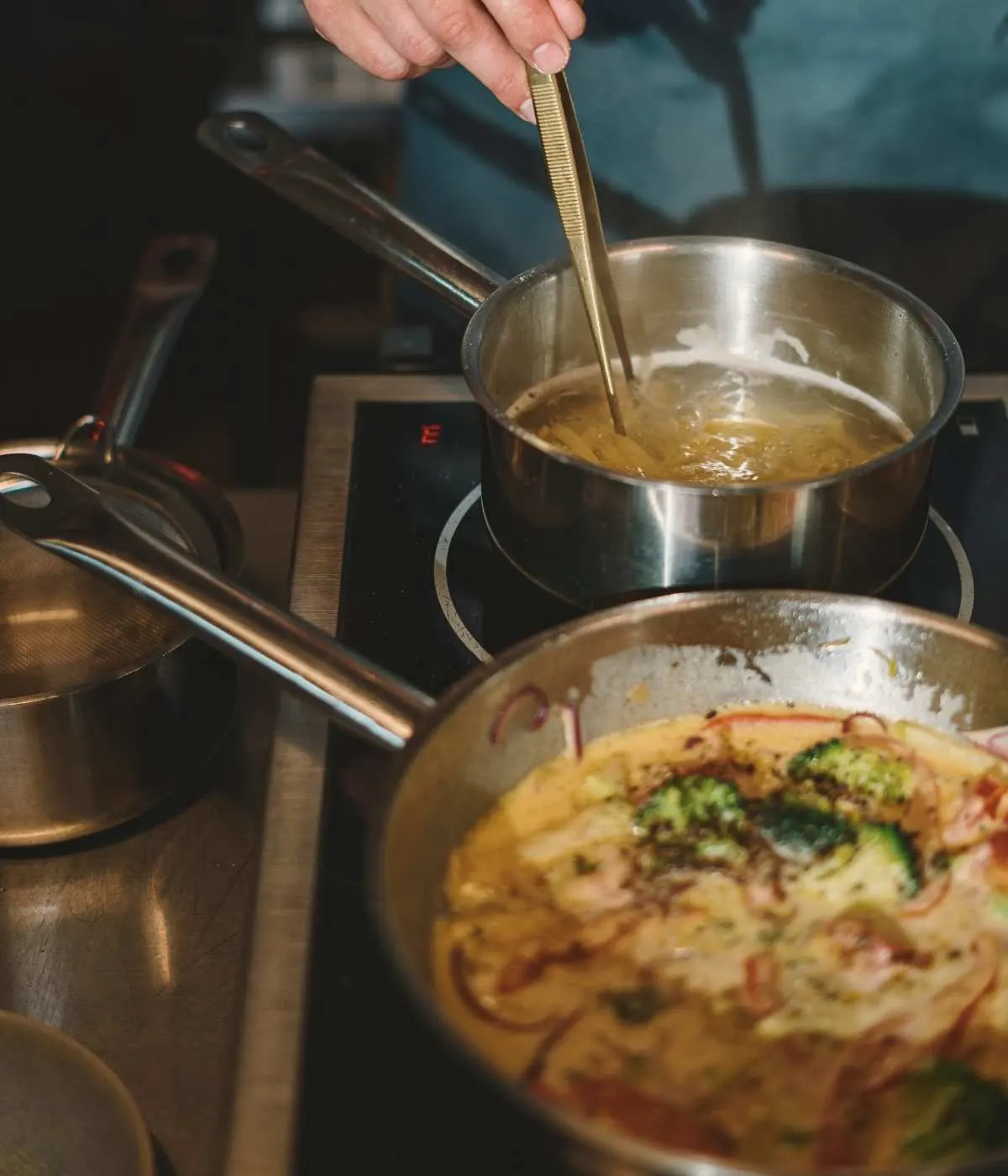
What Are The Healthiest Cookware Materials (Pros / Cons)
So, for those of you on the lookout for the healthiest cookware, here are some of the healthiest cookware materials to look for when buying a brand you don’t know, complete with their pros and cons:
Stainless Steel
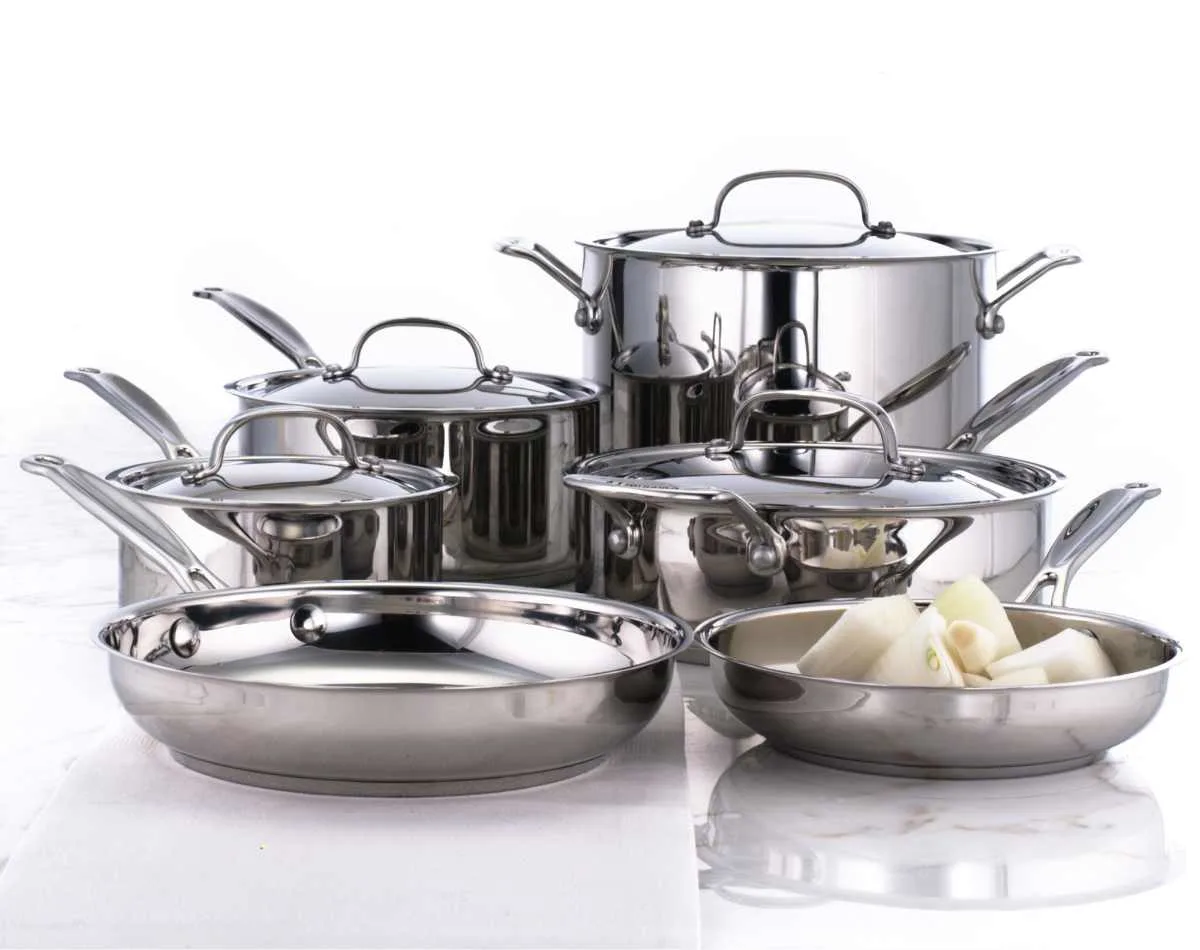
Related: Best Diet & Foods For Healing At Cellular Level (+PDF List)
Heads up: some links are affiliated & I may receive a small commission from qualifying sales. For more info see my disclaimer policy.
Pros:
- One of the safest cookware out there when it comes to non-toxic options. The highest quality is surgical grade stainless steel. Some brands use cheap alloys or scrap metal, avoid those.
- Durable and resistant to scratches and dents and can perform for a lifetime.
- Doesn’t leach harmful chemicals into food and doesn’t react with acidic foods (won’t alter the flavor of foods).
- Provides even heating, especially when it has an aluminum or copper core.
- The allergy friendly variety is nickel free. The nickel is usually added to enhance resistance to corrosion.
- Dishwasher-safe and oven safe (if it doesn’t has any plastic elements attached).
- Safe for using abrasive scrubbing pads.
- Safest Stainless Steel Cookware Brands:
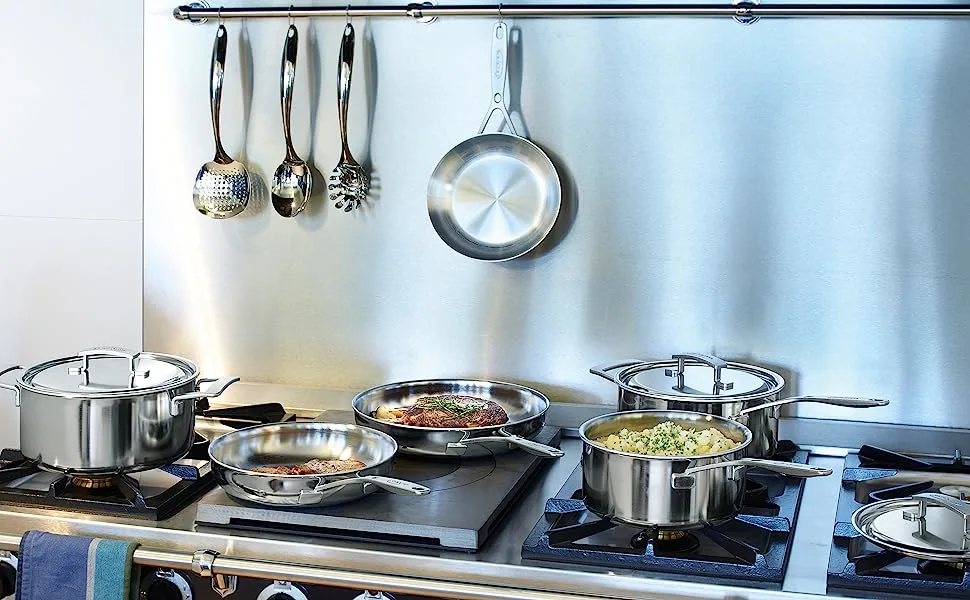
Cons:
- Foods, especially proteins, might stick to the surface if not properly pre-heated or if not used with the right amount of fat or oil.
- Stainless steel is not a great conductor of heat. This is why many stainless steel pots and pans incorporate an aluminum or copper core or base.
- High-quality stainless steel, particularly multi-ply with copper or aluminum cores, can be on the pricier side.
Cast Iron
Pros:
- Extremely durable and can last for generations if properly maintained.
- Natural, non-stick surface when seasoned correctly.
- Suitable for various cooking methodsfrom stovetop to oven, making it great for baking, frying or sautéing.
- Retains heat well, ensuring even cooking, making it excellent for searing and browning, althoug heat distribution is not that great.
- Healthiest Cast Iron Cookware Brands:
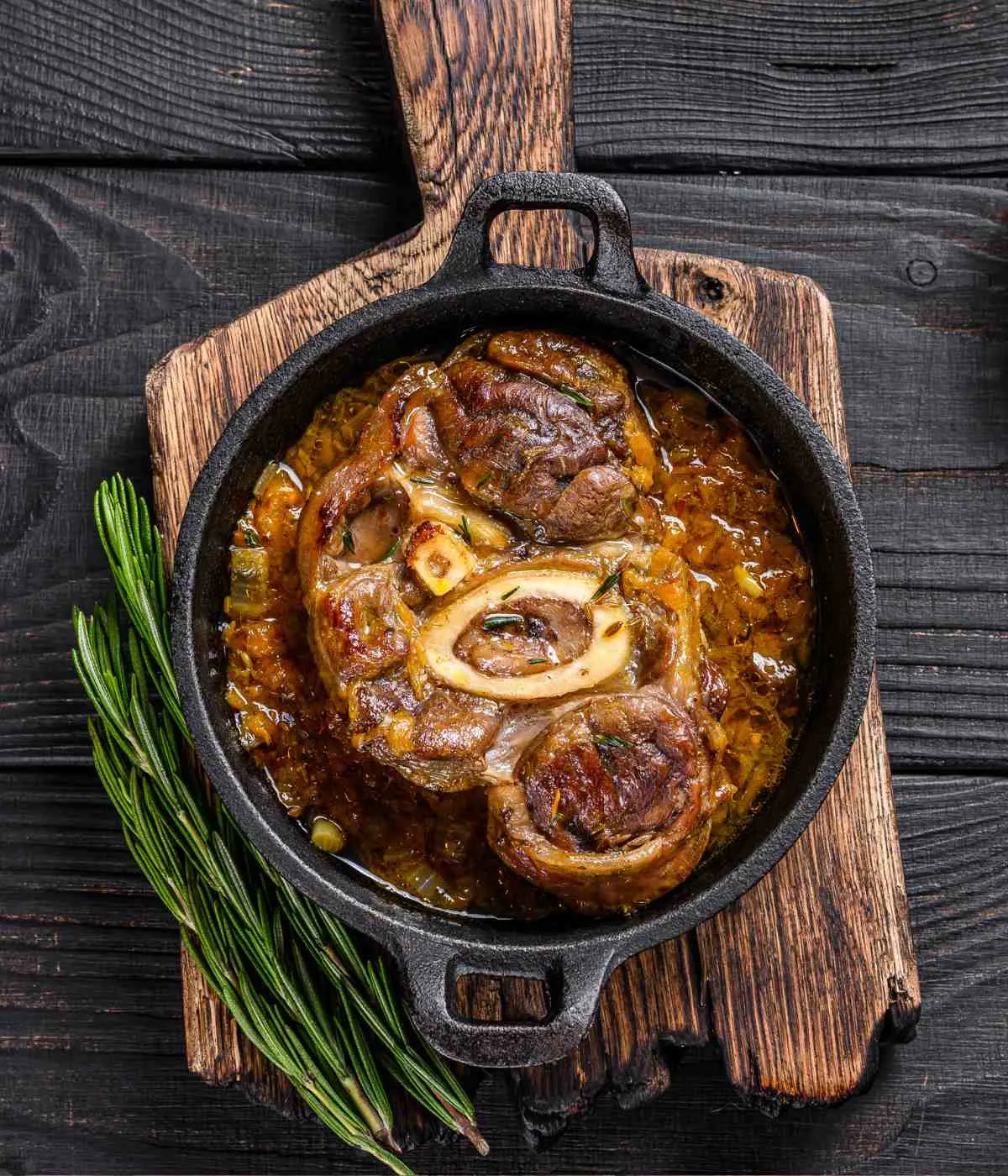
Cons:
- Cast iron pans are heavy, which can make handling, challenging.
- Requires regular seasoning to maintain its non-stick properties and prevent rust.
- Can react with acidic foods like tomatoes, which can affect the flavor of the dish and possibly strip the seasoning.
- Takes longer to heat up compared to other cookware materials.
- If not properly dried or if exposed to moisture for extended periods, cast iron can rust.
Ceramic (100% Pure Ceramic):
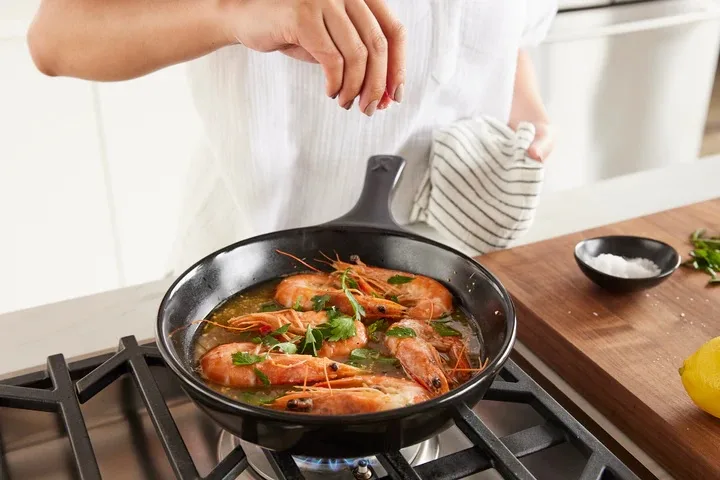
Pros:
- Free from harmful chemicals, PFOA, and metals.
- Does not release any harmful fumes, even at high temperatures when overheated.
- Made entirely from kiln-baked clay so no chemical coating to come off into your food.
- Provides even heat distribution and withstands extreme high heat.
- Resistant to scratches (metal utensil-safe) and can go from stovetop to oven.
- Doesn’t need special care (no seasoning like the cas-iron types).
- More durable than glass cookware. Dishwasher and freezer-safe.
- Easier to clean than cast-iron or stainless steel.
Cons:
- There is a risk of cracking, or breaking if dropped or subjected to rapid temperature changes. Not induction stove-top friendly.
- High-quality pure ceramic cookware can be relatively expensive compared to other materials.
- While ceramic retains heat well, it might not distribute it as evenly as some metals, leading to potential hot spots.
Ceramic Coated Cookware:

Pros:
- This type of cookware usually consists of a metal base, such as aluminum or stainless steel, coated with a layer of ceramic. The ceramic layer gives it a non-stick property.
- The non-stick properties mean you can use less oil or butter when cooking, potentially resulting in healthier meals.
- These pots and pans are typically lightweight, easy to handle and easy to clean.
- More affordable than pure ceramic.
- Healthiest Ceramic Coated Cookware Brands:
- GreenPan SearSmart (Durable Diamond-infused Ceramic Coating, Hard Anodized Aluminum Core, Metal Utensil Safe).
- GreenPan Reserve, Lima or Valencia Pro (All have Hard Anodized Aluminum Core, Ceramic Coating and pretty affordable);
- Caraway Cookware Set (Aluminum Core, Ceramic Coating, Large Set) Or Bakeware Set.
- Redchef Pots & Pans (Ceramic Coating, Aluminum Base, Detachable Handles, Affordable);
- GreenLife or GreenPan Treviso (both have Tri-Ply Stainless Steel, Diamond-reinforced Ceramic).
Cons:
- The ceramic coating can wear down over time, especially if used with metal utensils or subjected to high temperatures repeatedly. Once the coating wears off, the underlying metal might be exposed.
- It needs special care: use silicone utensils for mixing and no abrasive scrubbing pads when washing.
- Not dishwasher or oven-safe.
- There have been concerns about the potential health implications of nanoparticles used to enhance the non-stick properties of the ceramic coating and improve its durability and heat distribution. However not all ceramic coated cookware contains nanoparticles, so choose the brand wisely.
Glass Cookware:
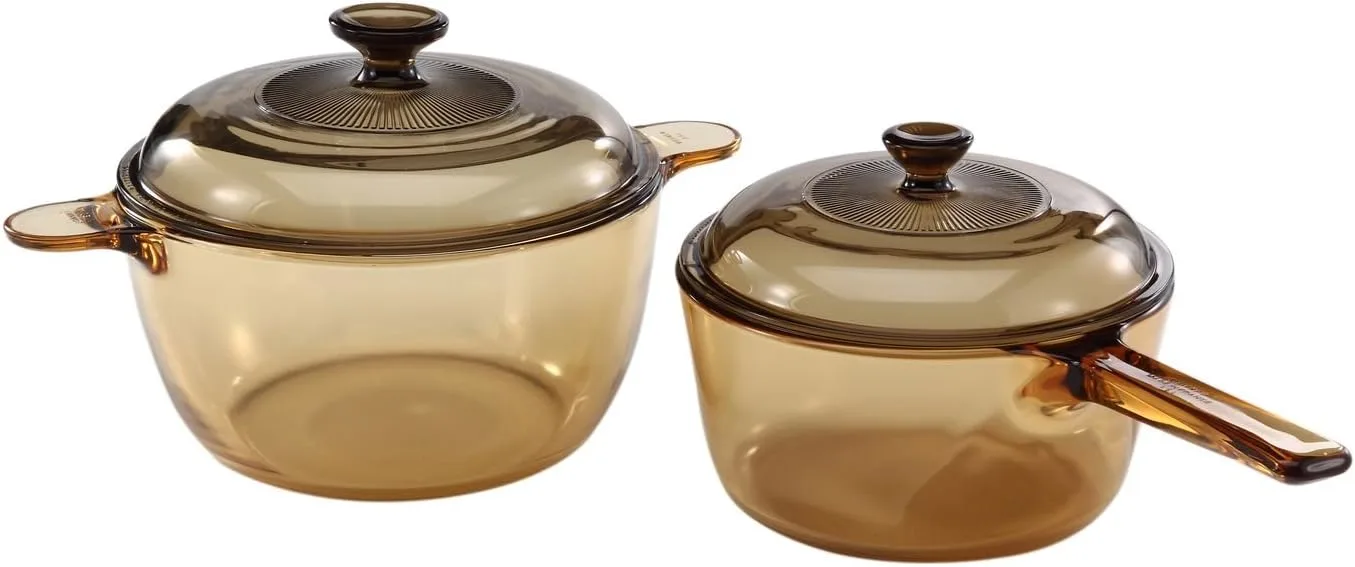
Pros:
- Non-reactive, meaning it won’t interact with the food you’re cooking.
- Excellent for baking and storing food.
- Transparent, allowing you to monitor your food while cooking.
- Healthiest Glass Cookware Brands:
- Visions (Cookware made with non-porous glass-ceramic material);
- Luminarc (French, non-porous glass-ceramic);
- NUTRIUPS (Casserole Dish).
- Pyrex Bakeware
Cons:
- Glass can break, chip, or crack if dropped, subjected to rapid temperature changes, or if it has imperfections.
- Glass cookware tends to be heavy, which can make handling larger pieces challenging.
- Glass doesn’t conduct heat as evenly as materials like aluminum or stainless steel, which can lead to hot spots or uneven cooking.
- It’s generally not suitable for stovetop cooking unless specified as stovetop safe. It also should not be exposed to broiler temperatures.
- Glass retains heat for a long time, which means that it remains hot even after it’s removed from the heat source. This can pose a burn risk if not handled with care.
Titanium Cookware:
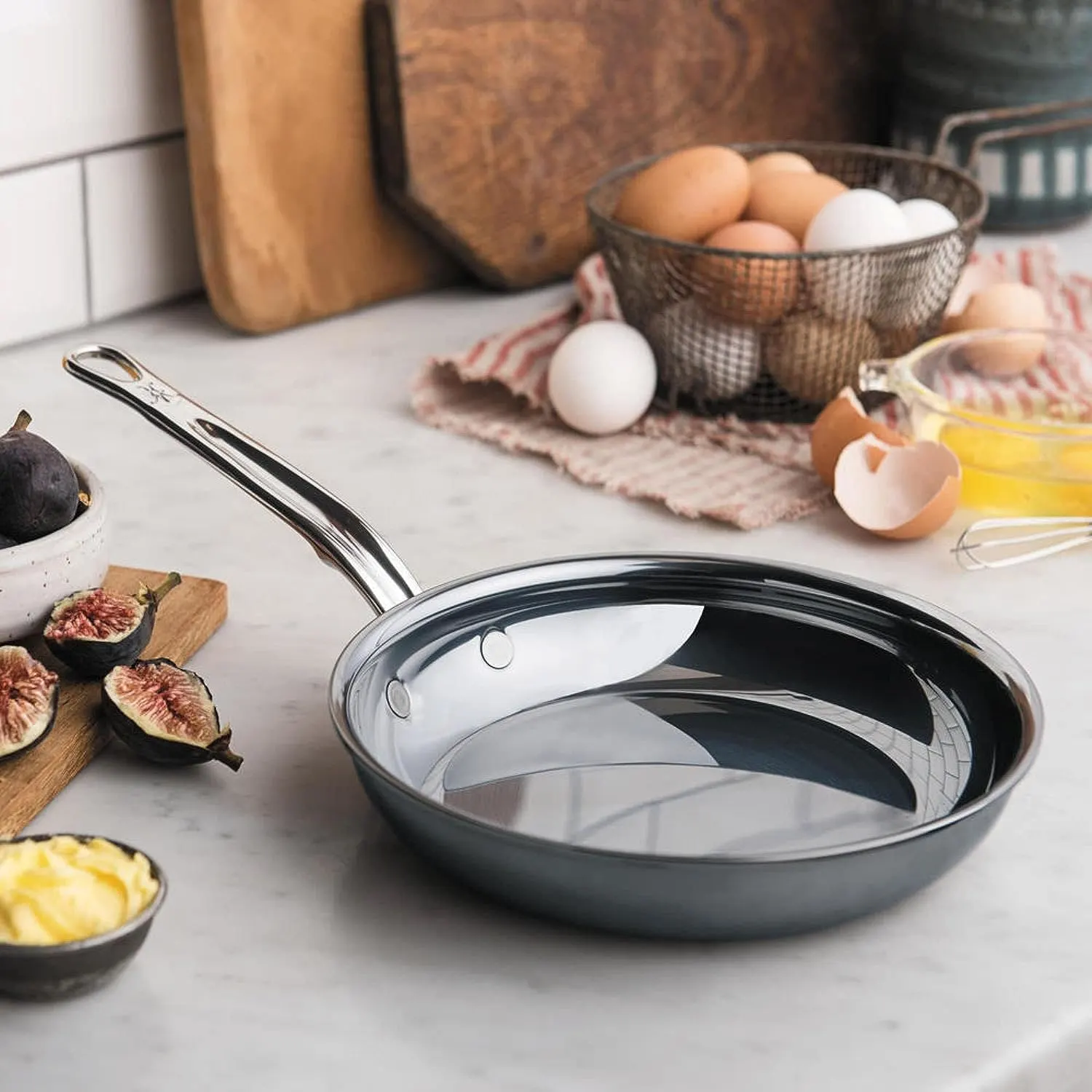
Pros:
- Lightweight and strong.
- It is a very stable, non-reactive metal.
- Resistant to rust and corrosion, resistant to scratching, staining and salt pitting.
- Heat up quickly and can distribute heat evenly, reducing cooking time.
- Typically used as a coating over other materials to provide a non-stick surface without harmful chemicals.
- Healthiest Titanium Cookware Brands:
Cons:
- High-quality titanium cookware can be expensive compared to other materials.
- Pure titanium pans don’t have a natural non-stick surface, so foods can stick if not properly oiled or if cooked over too high a heat.
- Over time and with exposure to heat, titanium can discolor, leading to a less shiny and pristine appearance.
Carbon Steel:
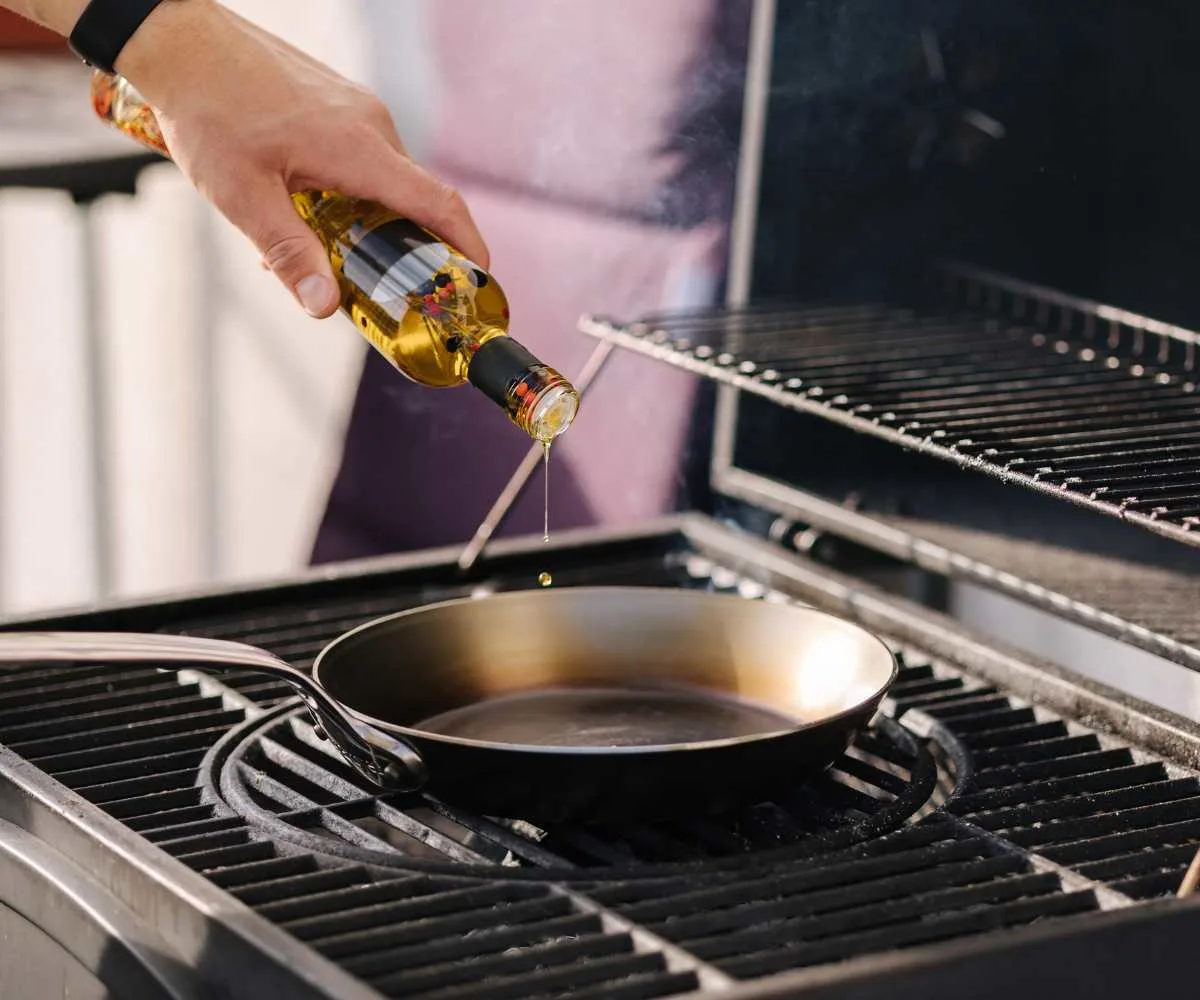
Pros:
- Compared to cast iron, carbon steel pans are lighter and smoother also heats up and cools down more quickly;
- Suitable for various cooking methods, from stovetop to oven, and can handle tasks from frying eggs to baking cornbread.
- Can last for generations.
- Healthiest Carbon Steel Cookware Brands:
Cons:
- Requires regular seasoning to maintain its non-stick properties and prevent rust. This can be more labor-intensive than the maintenance for stainless steel or non-stick pans.
- Like cast iron, carbon steel can react with acidic foods, potentially imparting a metallic taste and stripping the seasoning.
- Inconsistent with heat distribution and over time, the appearance can change due to the buildup of seasoning;
- If not properly dried or if left exposed to moisture, carbon steel can rust.
Natural Stone:

Pros:
- Offers a non-reactive surface, it’s non toxic, durable and resistent to scratches.
- Heats evenly, ensuring consistent cooking.
- Typically used in pizza stones and certain specialty pans.
- Consistent cooking temperatures once the pan is heated.
- Requires less oil or butter for cooking, which can result in healthier meals.
- Relatively easy to clean. Like cast iron, you should not wash stoneware with soap. You can scrape, wipe, and rinse well with water to clean;
- Healthiest Natural Stone Brands:
- ROCKSHEAT (Stone for pizza, cookies or bread).
- Pampered Chef Stoneware Loaf Pan
- Stone Derived Coating Brands:
- Stonedine (Ceramic finish, aluminum core).
- Granitestone (mineral coating, aluminum core).
- Mueller (Stone-derived Coating, Aluminum Body).
- Ozeri (Stone-derived coating, aluminum core);
- MICHELANGELO (Stone derived nonstick coating, die-cast aluminum body).
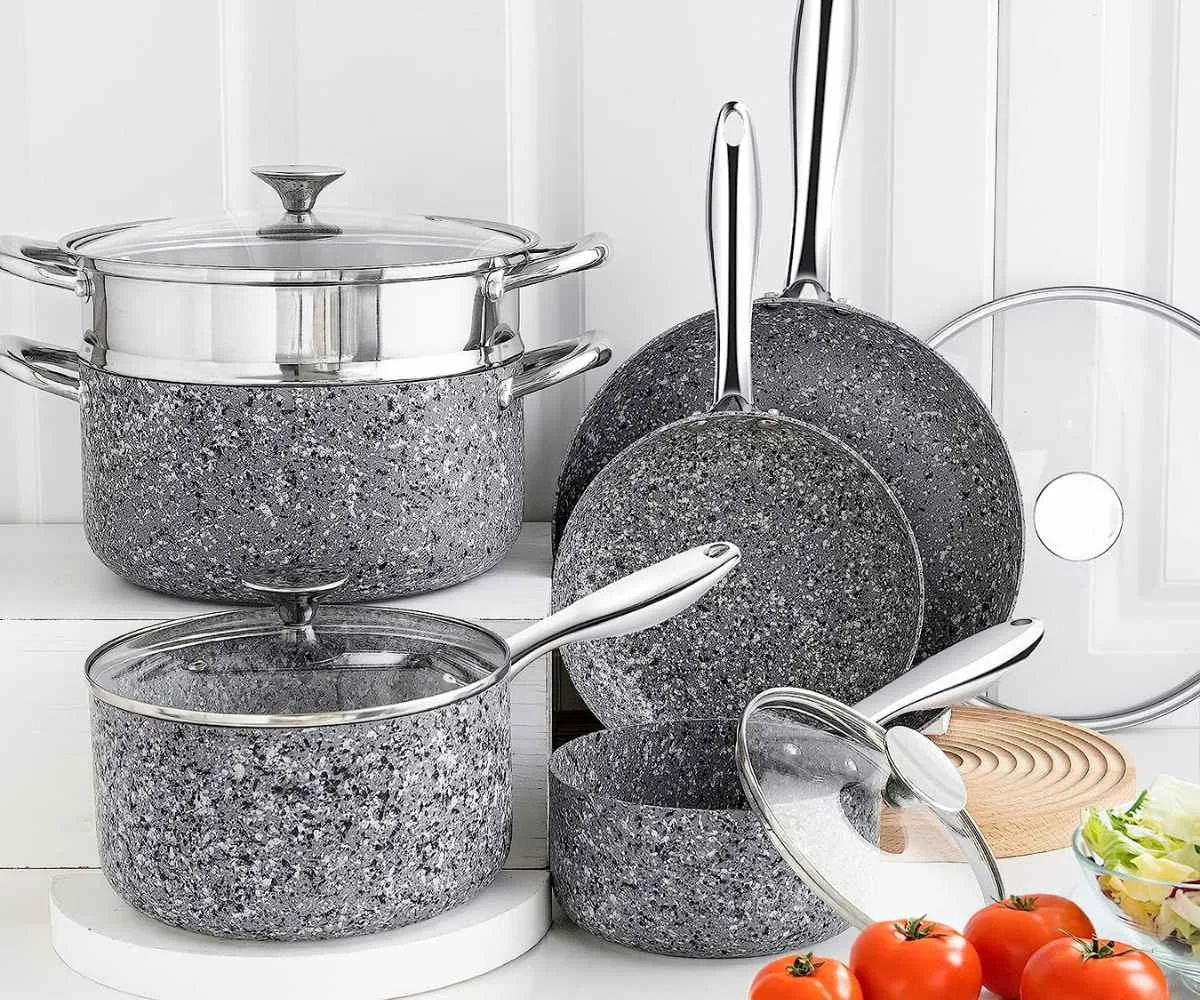
Cons:
- Tends to be on the heavier side (the ones made entirely of stone);
- High-quality stone cookware can be expensive.
- While it’s more scratch-resistant than traditional non-stick coatings, it still requires care to avoid using metal utensils or abrasive cleaners, which might damage the surface over time.
- Like other ceramic-based cookware, there’s a possibility for the surface to chip if dropped or banged against hard surfaces.
- The “stone” coating usually consists of a type of ceramic infused with particles to give it a rougher, stone-like texture and appearance. There is no actual stone in the coating.
- Some low-quality stoneware pieces can contain lead.
Hard-Anodized Aluminum:
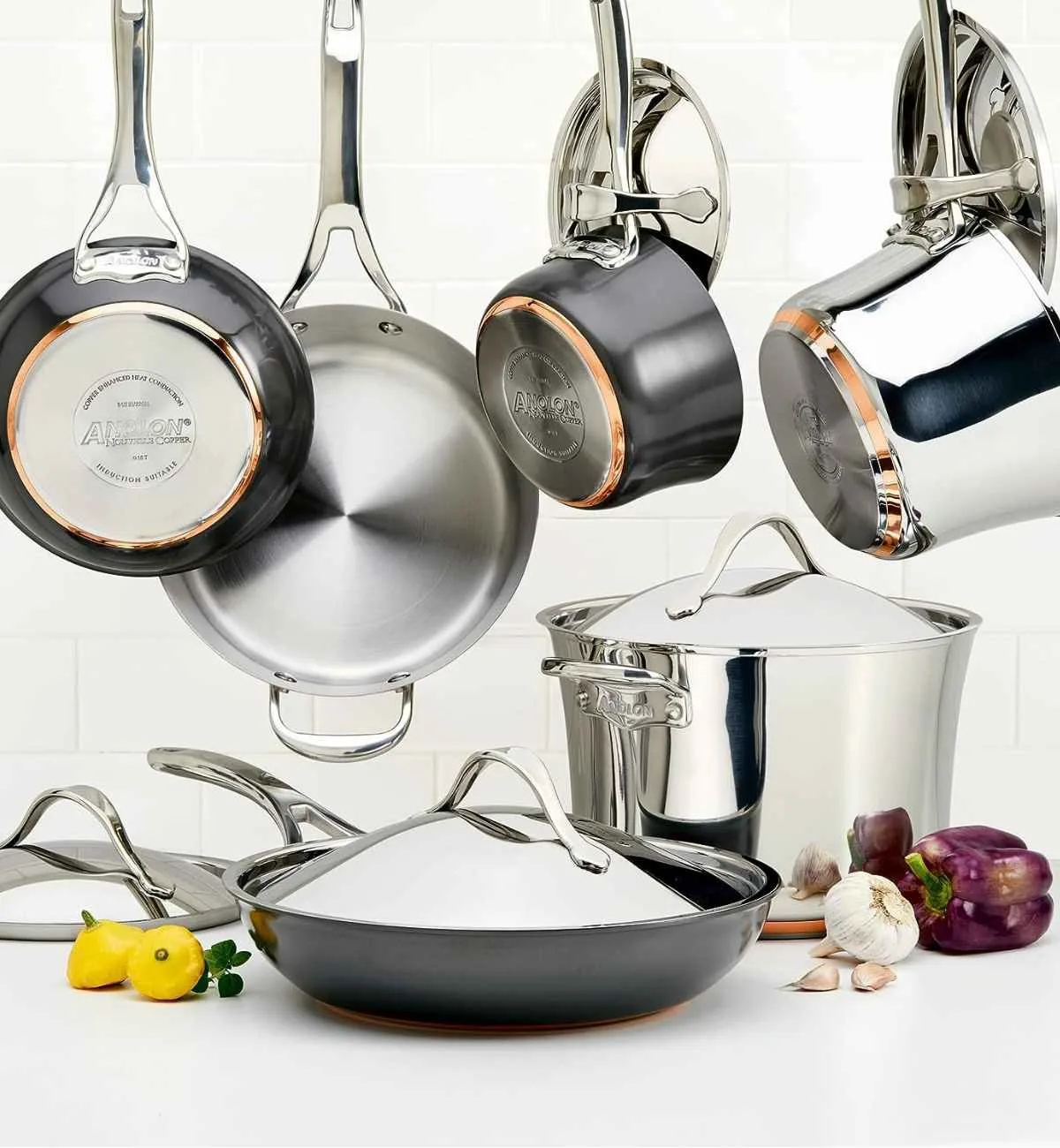
Pros:
- Twice as hard as stainless steel.
- Offers a non-stick surface without the chemicals found in traditional non-stick pans.
- Resistant to scratches and offers even heating.
- Healthiest Hard-Anodized Aluminum Cookware Brands:
- Anolon (Copper core between aluminum and magnetic stainless steel layers);
- Bialetti (Hard anodized aluminum base, titanium infused ceramic coat).
- KitchenAid (Hard anodized aluminum base, ceramic coating);
Cons:
- Typically not suitable for induction cooktops.
- More expensive than standard aluminum cookware.
- You need to avoid abrasive cleaning to preserve the surface. The anodized aluminum cookware transforms into non-anodized aluminum cookware after being used several times (especially id it doesnt have a protective coating), as the anodized layer is constantly being leached out during cooking.
- With extended use and high heat, the surface also might degrade.
Porcelain Enamel
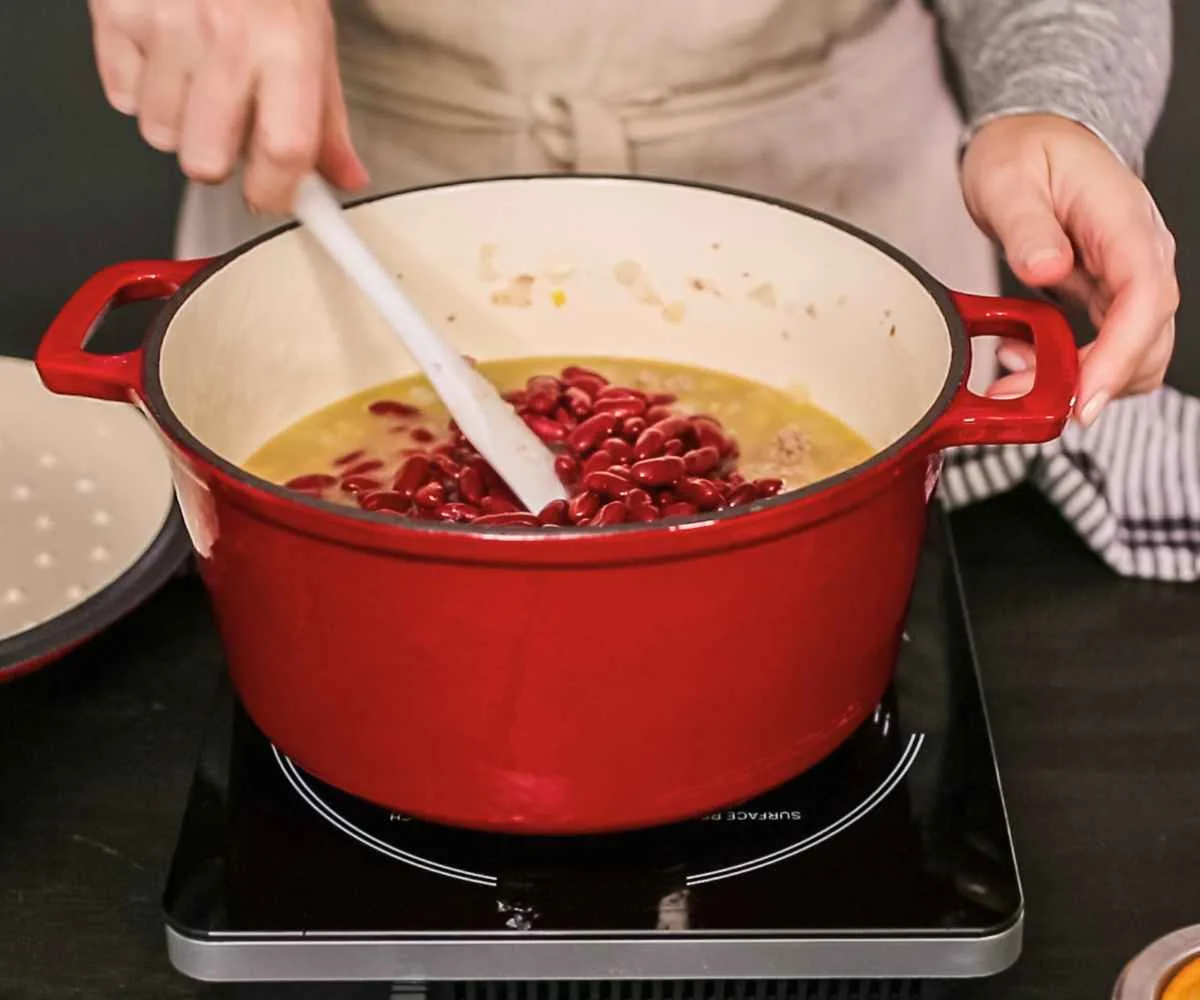
Pros:
- It is enameled cast iron – with the enamel being a type of glass.
- Porcelain Enamel will not rust.
- Won’t leach iron because of the enamel coating.
- Acidic food friendly. Acidic foods can strip cast iron of it’s seasoning.
- Best Enameled Cast Iron Cookware Brands:
- Basque (Cookware Set).
- Lodge (Casserole Dishes And Pots).
- Segretto (Casserole Pans).
- Le Creuset (French Cookware Set).
Cons:
- It will get scrached with time when metal utensils are used.
- It will discolor, wear out and lose its shiny glaze with sudden temeperature change.
- Cheap porcelain enamel brands may chip off easily. Good quality is expensive.
FAQs on The Healthiest Cookware
Various materials are considered healthy, including stainless steel, cast iron, glass and ceramic-coated cookware. Your choice should depend on your cooking needs and personal preferences.
Newer non-stick options like ceramic or diamond infused ceramic are considered healthier and safer than older non-stick versions, but they may not be the healthiest cookware choice compared to materials like stainless steel or glass.
Even the hard anodized cookware can become more sensitive to metals leaching upon repeated use. According to a 2023 study the anodized aluminum cookware transforms into non-anodized aluminum cookware after being used several times, as the anodized layer is constantly being leached out during cooking.
Always check for labels that indicate the cookware is free from PFOA, PFAS, lead, and cadmium. Be wary of bargain pans, extremely cheap cookware might not adhere to safety standards.
Stainless steel pans are generally considered safer than older non-stick pans and even the new ones. They perform better over long term use, and don’t pose the risk of metal leaching.
The safest non-stick cookware is typically those made from hard anodized aluminum (as the core) which makes it more durable and less prone to leaching and covered with ceramic coatings, especially diamond reinforced ceramic (it lasts longer). Such brands as Blue Diamond and GreenPan.
Ceramic-coated pans, in particular, are often touted as a natural, environmentally-friendly, and non-toxic alternative to traditional non-stick surfaces.
Granite stone cookware isn’t necessarily made of stone. It’s usually just aluminum coated with non-stick coatings that aren’t any different from that of Teflon. Branding cookware as “stoneware” or “granite” is often a strategic marketing tactic to portray it as natural and long-lasting. If granite stoneware is devoid of PFAS, PFOA, and PTFE and utilizes a ceramic non-stick layer, it can be considered healthy.
Conclusion
What I truly hope you grasp from this is my recommendation to consider updating your cookware. Don’t underestimate the impact of quality cookware on your cooking and overall well-being.
It doesn’t have to be a huge financial commitment all at once; Given that it’s used frequently, the long-term benefits are significant. Imagine changing just one piece every three months; by year’s end, you’d have an entirely new set!
While there are high-end options available, there are also affordable choices (if you’re on a tight budget). There are plenty of cost-effective alternatives that don’t compromise on quality.
Whether it’s the ease of cooking, durability, or health benefits, the right cookware can transform your culinary experience.
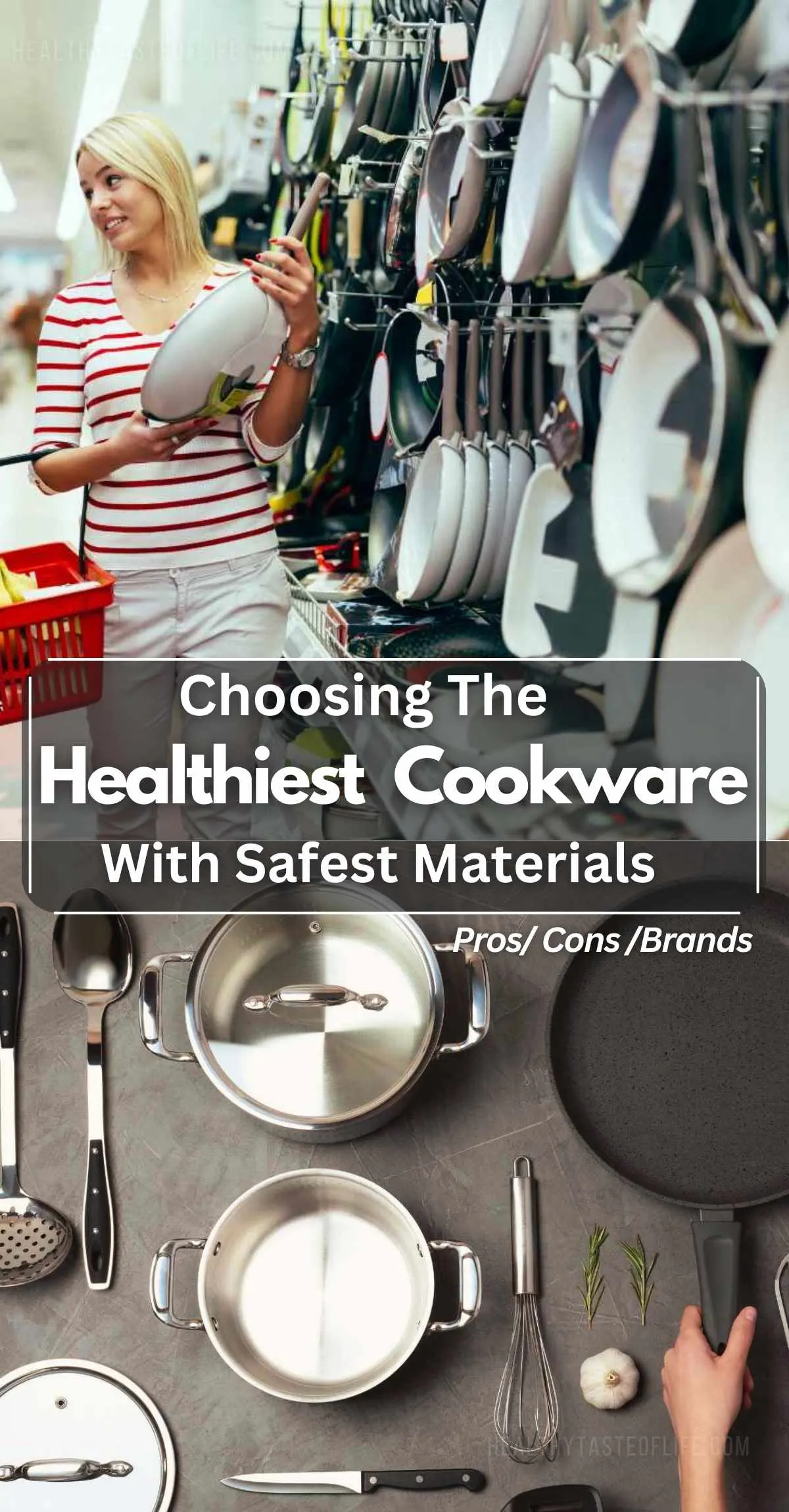
©HealthyTasteOfLife. Content and photographs are copyright protected and need prior permission to use. Copying and/or pasting full recipes to other websites and any social media is strictly prohibited. Sharing and using the link of this recipe is both encouraged and appreciated!
